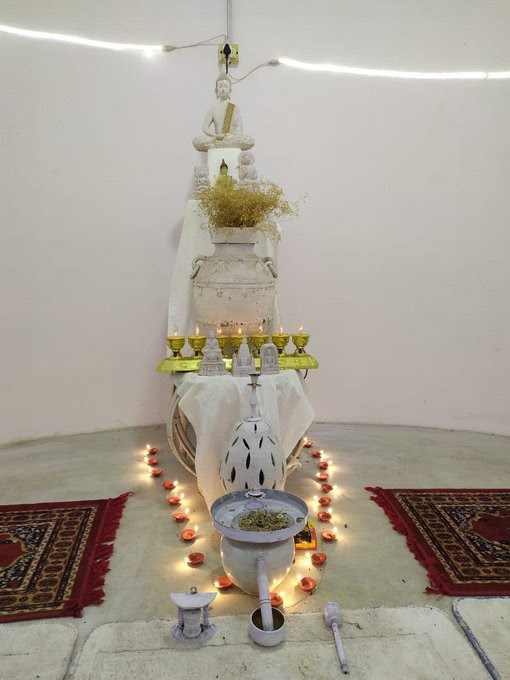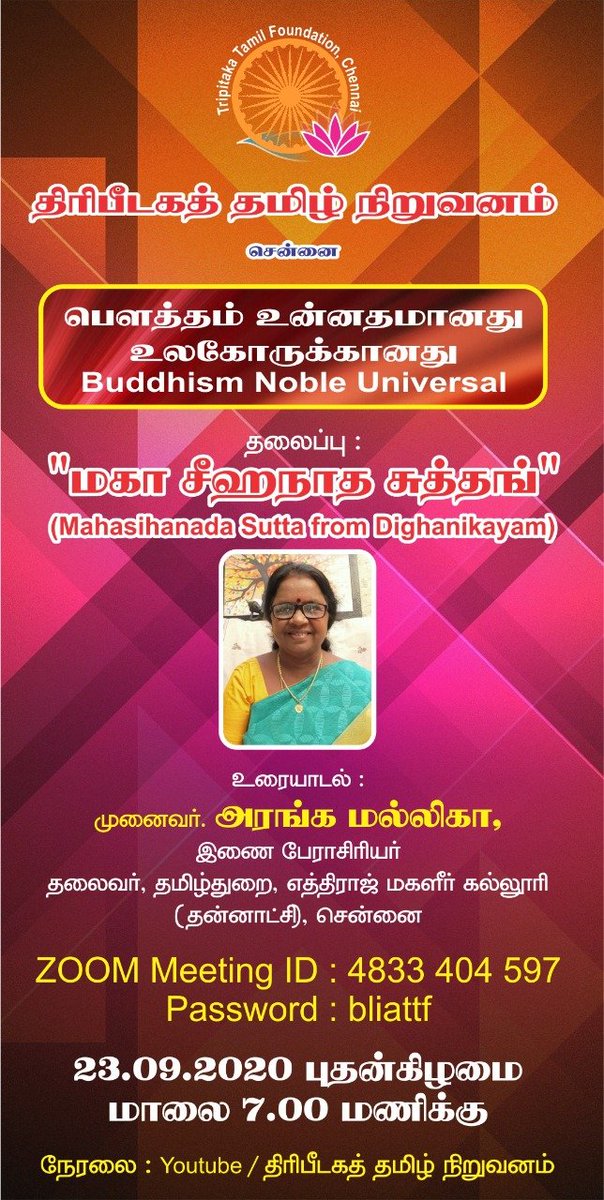


For
The Welfare, Happiness, Peace of All Sentient and Non-Sentient Beings and for them to Attain Eternal Peace as Final Goal.
KUSHINARA NIBBANA BHUMI PAGODA-It
is a 18 feet Dia All White Pagoda with a table or, but be sure
to having above head level based on the usual use of the room. in
116 CLASSICAL LANGUAGES and planning to project Important Places like
Lumbini, Bodh gaya, Saranath, Kushinara, Etc., in a circle vision akin
to Circarama
At
WHITE HOME
668, 5A main Road, 8th Cross, HAL III Stage,
Prabuddha Bharat Puniya Bhumi Bengaluru
Magadhi Karnataka State
you for converting the Dhamma in the letters to voice , always it is
easy to hear rather than reading, many lay people attained higher
stages in meditation by their right concentration and right
understanding, when Lord Buddha was giving the discourses.
Dr. M. Punnaji lesson on Majjhima Nikaya sutta 12 -
Mahāsīhanādasutta (The Greater Discourse on the Lion’s Roar) during
the weekly Sutta Class on 11th September 2017 at the Buddhist Maha
Vihara. To download a copy of the sutta in English:
தமிழில் திரபிடக மூன்று தொகுப்புகள்
இந்த
நூட்கள் வெளியீடு காட்சிமுறை உருவரைக்குறிப்பு தேவனாகரி எழுத்துப்
பிரதியில் திபிடக முக்கூடைகளின் சஹ்ஹுவ ஸாக்யன (ஆறாவது மன்றம்) பதிப்பு.
This outline displays the publication of books in the Devan±gari-script edition of the
Chaμμha Saag±yana (Sixth Council) Tipiμaka. The names of the volumes are displayed in italics with the suffix “-p±1⁄4i” indicating
the volume is part of the root Tipiμaka, rather than commentarial literature. This outline lists the root volumes only.
Please note: These books are in P±li only, in Devan±gari script, and are not for sale.
No set of English translations is available. For further information please see: www.tipitaka.org
விநய பியுயக Vinaya Piμaka
(மூன்று மண்டலங்கள், 5 நூட்களாக அச்சடிக்கப்பட்டது)
(Three divisions, printed in 5 books)
1.ஸுத்த விபாக(ஒரு சர மண்டலம்) [பிக்குக்கள் மற்றும் பிக்குனிகளுக்கான தன்னகம் கொண்ட
விதிகளின் இரண்டு நூட்கள்]
Sutta Vibhaaga [two books containing rules for the bhikkhus and
bhikkhunis, outlining eight classes of offences]
திபிடக முக்கூடைகள்
Tipiμaka (three “baskets”)
ஸுத்த பியுயக
( ஐந்து திரட்டுகள்)
Sutta Piμaka
(Five nik±yas, or collections)
The
Sutta Piṭaka contains the essence of the Buddha’s teaching regarding
the Dhamma. It contains more than ten thousand suttas. It is divided in
five collections called Nikāyas (A multitude, assemblage; a collection; a
class, order, group; an association, fraternity, congregation; a house,
dwelling).
நெறி முறைக் கட்டளை ஆணைக் கூடை தம்மா பற்றி புத்தர்
கற்பித்த மெய்ம்மை சாறு நிரம்பியது. அது பதினாயிரம் விஞ்சி மிகுதியாக நெறி
முறைக் கட்டளை ஆணை நிரம்பியது. அது நிகாய ( ஒரு பேரெண்ணிக்கை,
ஒன்றுகூடுதல் ஒரு வகை, வரிசைமுறை, குவியல், ஓர் கூட்டமைப்பு,
பொதுநோக்கங்கள் கொண்ட, ஒருங்கு கூட்டுதல், ஒரு குடும்பமரபுக் குழு,
கருத்தூன்றி நீடித்த ) என அழைக்கப்படும் ஐந்து திரட்டுகளாக பிரிந்துள்ளது.
Dīgha Nikāya
[dīgha:
long] The Dīgha Nikāya gathers 34 of the longest discourses given by
the Buddha. There are various hints that many of them are late additions
to the original corpus and of questionable authenticity.
நீளமான நிகாய (திரட்டுகள்)
புத்தரால் கொடுக்கப்பட்ட 34 நீளமான போதனையுரைகள் கொய்சகமாக்கப்பட்டது.
Majjhima Nikāya
[majjhima:
medium] The Majjhima Nikāya gathers 152 discourses of the Buddha of
intermediate length, dealing with diverse matters.
மத்திம (நடுத்தரமான) நிகாய (திரட்டுகள்)
புத்தரால்
கொடுக்கப்பட்ட 152 மத்திம ( நடுத்தரமான நீட்சி ) பல்வேறு வகைப்பட்ட
விஷயங்கள் செயல் தொடர்பு உடன் போதனையுரைகள் கொய்சகமாக்கப்பட்டது.
Saṃyutta Nikāya
[samyutta:
group] The Saṃyutta Nikāya gathers the suttas according to their
subject in 56 sub-groups called saṃyuttas. It contains more than three
thousand discourses of variable length, but generally relatively short.
குவியல் நிகாய (திரட்டுகள்)
குவியல்
நிகாய (திரட்டுகள்) என அழைக்கப்படும் நெறி முறைக் கட்டளை ஆணை அவற்றினுடைய
பொருளுக்கு ஏற்ப 56 பங்குவரி குவியலாக கொய்சகமாக்கப்பட்டது. அது மூவாயிரம்
விஞ்சி மிகுதியாக மாறும் தன்மையுள்ள நீளம் ஆனால் பெரும்பாலும் ஒப்பு
நோக்காக சுருக்கமான நெறி முறைக் கட்டளை ஆணை நிரம்பியது.
Aṅguttara Nikāya
[aṅg:
factor | uttara: additionnal] The Aṅguttara Nikāya is subdivized in
eleven sub-groups called nipātas, each of them gathering discourses
consisting of enumerations of one additional factor versus those of the
precedent nipāta. It contains thousands of suttas which are generally
short.
கூடுதல் அங்கமான (ஆக்கக்கூறு) நிகாய (திரட்டுகள்)
இறங்குதல்
காரணி, கருத்தைக் கவர்கிற, கீழ் நோக்கி அல்லது ஏறத்தாழ தற்போதைக்கு
உதவுகிற என அழைக்கப்படும் பதினொன்று பங்குவரி, ஒவ்வொன்று
கொய்சகமாக்கப்பட்டது நெறி முறைக் கட்டளை ஆணை கணக்கிடல் ஆக்கை ஒரு
குறிப்பிட்ட கூடுதல் ஆக்கக் கூறு எதிராக அவை முன்னோடி மாதிரி இறங்குதல்
காரணி. அது ஆயிரக்கணக்கான பெரும்பாலும் சுருக்கமான நெறி முறைக் கட்டளை ஆணை
நிரம்பியது. தன்னகம் கொண்டிரு
Khuddaka Nikāya
[khuddha: short,
small] The Khuddhaka Nikāya short texts and is considered as been
composed of two stratas: Dhammapada, Udāna, Itivuttaka, Sutta Nipāta,
Theragāthā-Therīgāthā and Jātaka form the ancient strata, while other
books are late additions and their authenticity is more questionable.
சுருக்கமான, சிறிய நிகாய (திரட்டுகள்)
சுருக்கமான,
சிறிய நிகாய (திரட்டுகள்) வாசகம் மற்றும் ஆலோசனை மிக்க மாதிரி தணிந்த
இரண்டு படுகைகள் : தம்மபத (ஒரு சமய சம்பந்தமான முற்றுத் தொடர் வாக்கியம் ,
மூன்று கூடைகள் நூட்கள் ஒன்றின் பெயர் , தம்மாவின் உடற்பகுதி அல்லது
பாகம்), உதான (வார்த்தைகளால்,
மேல்நோக்கிய பேரார்வம், ஆவல் கொண்ட அல்லது
மகிழ்ச்சி கூற்று, சொற்றொடர் , உணர்ச்சிமிக்க உறுதலுணர்ச்சி, மகிழ்ச்சி
அல்லது மனத்துயரம் இரண்டனுள் ஒன்று), இதிவுத்தக ( இது குத்தகனிகாய நான்காம்
புத்தகம் பெயர்), ஸுத்த ( ஒரு சரம், இழை ,: புத்தசமயம், சவுகதநூல் ஒரு
பாகம்; ஒரு விதி, நீதி வாக்கியம் இறங்குதல் காரணி),தேரகாத-தேரிகாத(
தேராக்களுக்கு உரியதானது), மற்றும் ஒரு சரடு ஜாதக ( பிறப்பு , பிறப்பிடம் ,
ஒரு பிறப்பு அல்லது : புத்தசமயம் விவேகம் வாழ்தல் , ஒரு ஜாதக, அல்லது
புத்தரின் முந்திய பிறப்பு கதைளில் ஒன்று.)
Sutta Piṭaka -Digha Nikāya
DN 9 -
Poṭṭhapāda Sutta
{excerpt}
— The questions of Poṭṭhapāda —
Poṭṭhapāda asks various questions reagrding the nature of Saññā.
Note: plain texts
ஸஞ்யா
நு கொ பந்தெ பதமங் உப்பஜ்ஜதி, பச்சா ஞானங்? உதாஹு ஞானங் பதமங் உப்பஜ்ஜதி,
பச்சா ஸஞ்யா? உதாஹு ஸஞ்யா ச ஞானங்ச அபுபங் ஆசரிமங் உப்பஜ்ஜந்தி?’ தி.
Saññā nu kho bhante paṭhamaṃ uppajjati, pacchā ñāṇaṃ? Udāhu ñāṇaṃ
paṭhamaṃ uppajjati, pacchā saññā? Udāhu saññā ca ñāṇañca apubbaṃ
acarimaṃ uppajjantī?’ ti.
இப்பொழுது, பந்த்தே, எது முதலாவது எழும்புவது
புலனுணர்வா,ஞானங் அடுத்ததா? அல்லது ஞானங் முதலாவது மற்றும் புலனுணர்வு
அடுத்ததா? அல்லது ஒரே நேரத்தில் புலனுணர்வும் ஞானமும் எழும்புகிறதா?
Now, lord, does perception arise first, and knowledge after; or does
knowledge arise first, and perception after; or do perception &
knowledge arise simultaneously?
ஸஞ்யா கொ பொத்தபாதப தமங் உப்பஜ்ஜதி பச்சா
ஞானங். ஸன்யுப்பாதா ச பன ஞானுப்பாதொ ஹோதி. ஸொ ஏவங் பஜானாதி: இதப்பச்சாயா
கிர மெ ஞானங் உதபாதிதி. இமினா கொ ஏதங் பொத்தபாத பரியாயென வேதிதப்பங், யதா
ஸஞ்யா பதமங் உப்பஜ்ஜதி பச்சா ஞானங், ஸன்யுப்பாதொ ச பன ஞானுப்பாதொ
ஹோதி’தி.
Saññā kho poṭṭhapāda paṭhamaṃ uppajjati pacchā ñāṇaṃ. Saññuppādā ca pana
ñāṇuppādo hoti. So evaṃ pajānāti: idappaccayā kira me ñāṇaṃ udapādīti.
Iminā kho etaṃ poṭṭhapāda pariyāyena veditabbaṃ, yathā saññā paṭhamaṃ
uppajjati pacchā ñāṇaṃ, saññuppādo ca pana ñāṇuppādo hotī’ ti.
பொத்தபாத, முதலாவது
புலனுணர்வும் பின்னால் ஞானம் எழும்புகிறது.மற்றும் புலனுணர்வு
எழும்புகிறபோது ஞானம் எழும்புகிறது. ஒரு பிரித்தறியும் நிலை சார்ந்துள்ள
என்னுடைய இந்த ஞானம் எழும்பியது. இவ்வழியான வரம்பின் காரண ஆய்வால் ஒருவர்
எப்படி முதலாவது புலனுணர்வு எழும்புகிறது மற்றும் ஞானம் அடுத்து என்று உணர
முடியும் மற்றும் எவ்வாறு புலனுணர்வு எழும்பியதால், ஞானம் எழும்பிமயது
என்றும்.
Potthapada, perception arises first, and
knowledge after. And the arising of knowledge comes from the arising of
perception. One discerns, ‘It’s in dependence on this that my knowledge
has arisen.’ Through this line of reasoning one can realize how
perception arises first, and knowledge after, and how the arising of
knowledge comes from the arising of perception.
Sutta Piṭaka-Digha Nikāya
DN 16 - (D ii 137)
Mahāparinibbāna Sutta
{excerpts}
— The last instructions —
[mahā-parinibbāna]
This
sutta gathers various instructions the Buddha gave for the sake of his
followers after his passing away, which makes it be a very important set
of instructions for us nowadays.
Note: infobubbles on all Pali words except in section with light green background color
Dhammādāsaṃ
nāma dhamma-pariyāyaṃ desessāmi, yena samannāgato ariyasāvako
ākaṅkhamāno attanāva attānaṃ byā-kareyya: ‘khīṇa-nirayo-mhi
khīṇa-tiracchāna-yoni khīṇa-pettivisayo khīṇ’āpāya-duggati-vinipāto,
sotāpanno-hamasmi avinipāta-dhammo niyato sambodhi-parāyaṇo’ ti.
(The Mirror of the Dhamma)
I
will expound the discourse on the Dhamma which is called Dhammādāsa,
possessed of which the ariyasāvaka, if he so desires, can declare of
himself: ‘For me, there is no more niraya, no more tiracchāna-yoni, no
more pettivisaya, no more state of unhappiness, of misfortune, of
misery, I am a sotāpanna, by nature free from states of misery, certain
of being destined to sambodhi.
தமிழ்
(தம்மாவின் உருப்பளிங்கு)
நான்
Dhammādāsa (தம்மாவின் உருப்பளிங்கு) என கருதப்படும் தம்மாவை
வியாக்கியானம் பண்ண பிரசங்கம் செய்ய விரும்புகிரேன்,ariyasāvaka (புனிதமான
சீடர்)ஆக ஆட்கொண்டு,ஒருவேளை அவர் தானே விரும்பி உறுதியாக்கிக் கொண்டால்:
‘ஆக
எனக்கு, இன்னும் மேலும் niraya (நரகம்) இல்லை,இன்னும் மேலும்
tiracchāna-yoni ( மிருகம சாம்ராஜ்யம்) இல்லை,இன்னும் மேலும் pettivisaya
(ஆவிகள் சாம்ராஜ்யம்) இல்லை,இன்னும் மேலும்
பாக்கியவீனம்,துரதிருஷ்டம்,துக்கம், நிலை இல்லை, நான் sotāpanna (புனல்
பிரவேசி), இயற்கையாக துக்க நிலையில் இருந்து விடுவிக்கப்பட்டவன்,sambodhi
(முழுக்க தூக்கத்திலிருந்து விழிப்பு) ஆக சேர இருத்தல் உறுதி.
Katamo
ca so, Ānanda, dhammādāso dhamma-pariyāyo, yena samannāgato ariyasāvako
ākaṅkhamāno attanāva attānaṃ byā-kareyya: ‘khīṇa-nirayo-mhi
khīṇa-tiracchāna-yoni khīṇa-pettivisayo khīṇ’āpāya-duggati-vinipāto,
sotāpanno-hamasmi avinipāta-dhammo niyato sambodhi-parāyaṇo’ ti?
And
what, Ānanda, is that discourse on the Dhamma which is called
Dhammādāsa, possessed of which the ariyasāvaka, if he so desires, can
declare of himself: ‘For me, there is no more niraya, no more
tiracchāna-yoni, no more pettivisaya, no more state of unhappiness, of
misfortune, of misery, I am a sotāpanna, by nature free from states of
misery, certain of being destined to sambodhi?
மற்றும் என்ன,Ānanda
(ஆனந்தா),தம்மா மீது ஆன அந்த பிரசங்கம் Dhammādāsa (தம்மாவின்
உருப்பளிங்கு) என கருதப்படும் தம்மாவை வியாக்கியானம் பண்ண பிரசங்கம் செய்ய
விரும்புகிரேன்,ariyasāvaka (புனிதமான சீடர்)ஆக ஆட்கொண்டு,ஒருவேளை அவர்
தானே விரும்பி உறுதியாக்கிக் கொண்டால்:
‘ஆக எனக்கு, இன்னும் மேலும்
niraya (நரகம்) இல்லை,இன்னும் மேலும் tiracchāna-yoni ( மிருகம
சாம்ராஜ்யம்) இல்லை,இன்னும் மேலும் pettivisaya (ஆவிகள் சாம்ராஜ்யம்)
இல்லை,இன்னும் மேலும் பாக்கியவீனம்,துரதிருஷ்டம்,துக்கம், நிலை இல்லை, நான்
sotāpanna (புனல் பிரவேசி), இயற்கையாக துக்க நிலையில் இருந்து
விடுவிக்கப்பட்டவன்,sambodhi (முழுக்க தூக்கத்திலிருந்து விழிப்பு) ஆக சேர
இருத்தல் உறுதி தானே?
Idh’ānanda, ariyasāvako Buddhe aveccappasāda samannāgato hoti:
Here, Ānanda, an ariyasāvaka is endowed with Buddhe aveccappasāda:
இங்கு,ஆனந்தா,புனிதமான சீடர் Buddhe aveccappasāda (புத்தர் இடத்தில் தன்னம்பிக்கை)யாக குணிக்கப் படுகிரார்.
‘Itipi
so bhagavā arahaṃ sammāsambuddho vijjācaraṇasampanno sugato lokavidū
anuttaro purisadammasārathi satthā devamanussānaṃ buddho bhagavā’ ti.
Dhamme aveccappasāda samannāgato hoti:
He is endowed with Dhamme aveccappasāda:
Dhamme aveccappasāda:(தம்மா இடத்தில் தன்னம்பிக்கை)யாக குணிக்கப் படுகிரார்.
‘Svākkhāto bhagavatā dhammo sandiṭṭhiko akāliko ehipassiko opaneyyiko paccattaṃ veditabbo viññūhī’ ti.
Saṅghe aveccappasāda samannāgato hoti:
He is endowed with Saṅghe aveccappasāda:
Saṅghe aveccappasāda (சான்றோர் இடத்தில் தன்னம்பிக்கை)யாக குணிக்கப் படுகிரார்.
‘Suppaṭipanno
bhagavato sāvakasaṅgho, ujuppaṭipanno bhagavato sāvakasaṅgho,
ñāyappaṭipanno bhagavato sāvakasaṅgho, sāmīcippaṭipanno bhagavato
sāvakasaṅgho yadidaṃ cattāri purisayugāni aṭṭha purisapuggalā, esa
bhagavato sāvakasaṅgho āhuneyyo pāhuneyyo dakkhiṇeyyo añjalikaraṇīyo
anuttaraṃ puññakkhettaṃ lokassā’ ti.
Ariya-kantehi sīlehi samannāgato hoti
He is endowed with a sīla which is agreeable to the ariyas,
புனிதமானவர்கள் ஏற்றுக்கொள்ளத்தக்க சீலராக குணிக்கப் படுகிரார்.
akhaṇḍehi acchiddehi asabalehi akammāsehi bhujissehi viññūpasatthehi aparāmaṭṭhehi samādhisaṃvattanikehi.
Ayaṃ
kho so, Ānanda, dhammādāso dhamma-pariyāyo, yena samannāgato
ariyasāvako ākaṅkhamāno attanāva attānaṃ byā-kareyya: ‘khīṇa-nirayo-mhi
khīṇa-tiracchāna-yoni khīṇa-pettivisayo khīṇ’āpāya-duggati-vinipāto,
sotāpanno-hamasmi avinipāta-dhammo niyato sambodhi-parāyaṇo’ ti
This,
Ānanda, is the discourse on the Dhamma which is called Dhammādāsa,
possessed of which the ariyasāvaka, if he so desires, can declare of
himself: ‘For me, there is no more niraya, no more tiracchāna-yoni, no
more pettivisaya, no more state of unhappiness, of misfortune, of
misery, I am a sotāpanna, by nature free from states of misery, certain
of being destined to sambodhi.
இது, Ānanda (ஆனந்தா),தம்மா மீது ஆன
அந்த பிரசங்கம் Dhammādāsa (தம்மாவின் உருப்பளிங்கு) என கருதப்படும்
தம்மாவை வியாக்கியானம் பண்ண பிரசங்கம் செய்ய விரும்புகிரேன்,ariyasāvaka
(புனிதமான சீடர்)ஆக ஆட்கொண்டு,ஒருவேளை அவர் தானே விரும்பி உறுதியாக்கிக்
கொண்டால்:
’ஆக எனக்கு, இன்னும் மேலும் niraya (நரகம்) இல்லை,இன்னும் மேலும்
tiracchāna-yoni ( மிருகம சாம்ராஜ்யம்) இல்லை,இன்னும் மேலும் pettivisaya
(ஆவிகள் சாம்ராஜ்யம்) இல்லை,இன்னும் மேலும்
பாக்கியவீனம்,துரதிருஷ்டம்,துக்கம், நிலை இல்லை, நான் sotāpanna (புனல்
பிரவேசி), இயற்கையாக துக்க நிலையில் இருந்து விடுவிக்கப்பட்டவன்,sambodhi
(முழுக்க தூக்கத்திலிருந்து விழிப்பு) ஆக சேர இருத்தல் உறுதி.
…
…
Sato, bhikkhave, bhikkhu vihareyya sampajāno. Ayaṃ vo amhākaṃ anusāsanī.
Sato should you remain, bhikkhus, and sampajānos. This is our intruction to you.
Sato(கவனமான)
நீர் இருக்க வேண்டும்,bhikkhus (பிக்குக்கள்),மேலும் sampajānos(மாறா
இயல்பு அநித்தியத்தை பகுத்தறிதல்).இது தான் உமக்கு
எங்களுடைய போதனை.
Katha’ñca, bhikkhave, bhikkhu sato hoti? Idha, bhikkhave, bhikkhu
And how, bhikkhus, is a bhikkhu sato? Here, bhikkhus, a bhikkhu
மற்றும் எப்படி,பிக்கு, பிக்குக்கள் sato (கவனமான) இருக்கிரார்? இங்கு,பிக்குக்கள், ஒரு பிக்கு
kāye
kāyānupassī viharati ātāpī sampajāno satimā, vineyya loke
abhijjhā-domanassaṃ; vedanāsu vedanānupassī viharati ātāpī sampajāno
satimā, vineyya loke abhijjhā-domanassaṃ; citte cittānupassī viharati
ātāpī sampajāno satimā, vineyya loke abhijjhā-domanassaṃ; dhammesu
dhammānupassī viharati ātāpī sampajāno satimā, vineyya loke
abhijjhā-domanassaṃ.
Evaṃ kho, bhikkhave, bhikkhu sato hoti. Katha’ñca, bhikkhave, bhikkhu sampajāno hoti? Idha, bhikkhave,
Thus, bhikkhus, is a bhikkhu sato. And how, bhikkhus, is a bhikkhu sampajāno? Here, bhikkhus,
இப்படி,பிக்குக்கள்,பிக்கு
sato (கவனமான) இருக்கிரார்.மற்றும் எப்படி,பிக்குக்கள், பிக்கு
sampajānos(மாறா இயல்பு அநித்தியத்தை பகுத்தறிதல்)ஆகிரார்?
இங்கு,பிக்குக்கள்,
bhikkhu abhikkante paṭikkante sampajānakārī
hoti, ālokite vilokite sampajānakārī hoti, samiñjite pasārite
sampajānakārī hoti, saṅghāṭipattacīvaradhāraṇe sampajānakārī hoti, asite
pīte khāyite sāyite sampajānakārī hoti, uccārapassāvakamme
sampajānakārī hoti, gate ṭhite nisinne sutte jāgarite bhāsite tuṇhībhāve
sampajānakārī hoti.
Evaṃ kho, bhikkhave, bhikkhu sampajāno hoti. Sato, bhikkhave, bhikkhu vihareyya sampajāno. Ayaṃ vo amhākaṃ anusāsanī ti.
Thus, bhikkhus, is a bhikkhu sampajāno. Sato should you remain, bhikkhus, and sampajānos. This is our intruction to you.
இப்படி,பிக்குக்கள்,பிக்கு
sampajānos(மாறா இயல்பு அநித்தியத்தை பகுத்தறிதல்)ஆகிரார்,Sato(கவனமான)
நீர் இருக்க வேண்டும்,பிக்குக்கள்,மற்றும்sampajānos(மாறா இயல்பு
அநித்தியத்தை பகுத்தறிதல்),இது தான் உமக்கு
எங்களுடைய போதனை.
…
…
–
Sabbaphāliphullā kho, Ānanda, yamakasālā akālapupphehi. Te tathāgatassa
sarīraṃ okiranti ajjhokiranti abhippakiranti tathāgatassa pūjāya.
Dibbānipi mandāravapupphāni antalikkhā papatanti, tāni tathāgatassa
sarīraṃ okiranti ajjhokiranti abhippakiranti tathāgatassa pūjāya.
Dibbānipi candanacuṇṇāni antalikkhā papatanti, tāni tathāgatassa sarīraṃ
okiranti ajjhokiranti abhippakiranti tathāgatassa pūjāya. Dibbānipi
tūriyāni antalikkhe vajjanti tathāgatassa pūjāya. Dibbānipi saṅgītāni
antalikkhe vattanti tathāgatassa pūjāya.
– Ananda, the twin sala
trees are in full bloom, though it is not the season of flowering. And
the blossoms rain upon the body of the Tathagata and drop and scatter
and are strewn upon it in worship of the Tathagata. And celestial coral
flowers and heavenly sandalwood powder from the sky rain down upon the
body of the Tathagata, and drop and scatter and are strewn upon it in
worship of the Tathagata. And the sound of heavenly voices and heavenly
instruments makes music in the air out of reverence for the Tathagata.
-ஆனந்தா,பூவா
பருவகாலமாக இருந்த போதிலும், இரட்டை sala (சாலா) மரங்கள் முழு மலர்ச்சி
அடைந்து இருக்கிறது. மற்றும் Tathagata (குறைபாடற்றவரை) வழிபாடு செய்தல்
போல் Tathagata(குறைபாடற்றவர்) உடல் மேலே பூமழை பொழிந்து, துளி சிதற,
இரத்தினப்பிரபையாகியது. மற்றும் தேவலோக பவழமலர்கள் மற்றும் சுவர்க்கத்தைச்
சேர்ந்த சந்தன மரத் தூள் வானத்தில் இருந்து மழை கீழ் நோக்கி Tathagata
(குறைபாடற்றவர்) உடல் மேலே பொழிந்து, மற்றும் Tathagata (குறைபாடற்றவரை)
வழிபாடு செய்தல் போல் Tathagata(குறைபாடற்றவர்) உடல் மேலே பூமழை பொழிந்தது.
மற்றும் Tathagata(குறைபாடற்றவர்) போற்றுதலைக் காட்டுஞ் சமிக்கையால்
சுவர்க்கத்தைச் சேர்ந்த குரல் ஒலி மற்றும் இசைகருவிகள் காற்றுவெளியில்
வெளிப்படுத்தியது.
Na kho, Ānanda, ettāvatā Tathāgato sakkato vā
hoti garukato vā mānito vā pūjito vā apacito vā. Yo kho, Ānanda, bhikkhu
vā bhikkhunī vā upāsako vā upāsikā vā dhammānudhammappaṭipanno viharati
sāmīcippaṭipanno anudhammacārī, so Tathāgataṃ sakkaroti garuṃ karoti
māneti pūjeti apaciyati, paramāya pūjāya. Tasmātih’ānanda,
dhammānudhammappaṭipannā viharissāma sāmīcippaṭipannā
anudhammacārin’oti. Evañ’hi vo, Ānanda, sikkhitabba nti.
It is not
by this, Ānanda, that the Tathāgata is respected, venerated, esteemed,
paid homage and honored. But, Ananda, any bhikkhu or bhikkhuni, layman
or laywoman, remaining dhamm’ānudhamma’p’paṭipanna, sāmīci’p’paṭipanna,
living in accordance with the Dhamma, that one respects, venerates,
esteems, pays homage, and honors the Tathāgata with the most excellent
homage. Therefore, Ānanda, you should train yourselves thus: ‘We will
remain dhamm’ānudhamma’p’paṭipanna, sāmīci’p’paṭipanna, living in
accordance with the Dhamma’.
இதனால் மட்டும் அல்ல, ஆனந்தா,Tathagata
(குறைபாடற்றவரை) உபசரித்தது, மரியாதை செலுத்தியது, நன்குமதிக்கப் பட்டது,
மனந்திறந்த புகழுரைத்தது, கெளரவம் செலுத்தியது. ஆனால், ஆனந்தா, எந்த ஒரு
பிக்குவோ அல்லது பிக்குனியோ, உபாசகன் அல்லது
உபாசகி,dhamm’ānudhamma’p’paṭipanna, sāmīci’p’paṭipanna, தம்மாவிற்கு
பொருந்துமாறு பயிற்சிக்கிராரோ அவர் Tathagata (குறைபாடற்றவரை) உபசரித்தது,
மரியாதை செலுத்தி, நன்குமதித்து, மனந்திறந்த புகழுரைத்தது, கெளரவம்
செலுத்தி. மிக உயர்ந்த அளவு நேர்த்திவாய்ந்த மனந்திறந்த புகழுரையாற்றுவர்.
இதுக்காக, ஆனந்தா, நீங்கள், நீங்களாகவே பயிற்சித்தல் இதுதான்: நாங்கள்
dhamm’ānudhamma’p’paṭipanna, sāmīci’p’paṭipanna, தம்மாவிற்கு
பொருந்துமாறு வாழ்க்கை முறையில் தொடர்ந்திருப்போம்.
…
…
–
‘Siyā kho pan’ānanda, tumhākaṃ evam’assa: ‘atīta-satthukaṃ pāvacanaṃ,
natthi no satthā’ ti. Na kho pan’etaṃ, Ānanda, evaṃ daṭṭhabbaṃ. Yo vo,
Ānanda, mayā Dhammo ca Vinayo ca desito paññatto, so vo mam’accayena
satthā.
– ‘To some of you, Ānanda, it may occur thus: ‘The words of
the Teacher have ended, there is no longer a Teacher’. But this,
Ānanda, should not, be so considered. That, Ānanda, which I have taught
and made known to you as the Dhamma and the Vinaya, that will be your
Teacher after my passing away.
உங்கள் சிலர்ருக்கு, ஆனந்தா,இவ்வாறு நேரிடக் கூடும்:
கற்பிப்பவர்
வார்த்தைகள் தீர்ந்து விட்டது, இனி கற்பிப்பவர் இல்லை. ஆனால் இது,
ஆனந்தா, அவ்வாறு ஆலோசனை பண்ணப்படாது. அது, ஆனந்தா,எவை நான் பாடம் படிப்பிது
மற்றும் உங்களை அறிந்திருக்க செய்துமுடித்த Dhamma and Vinaya (தம்மாவும்
வினயாவும்) அது என்னுடைய இறப்புக்கு அப்பால் உங்களுடைய கற்பிப்பவராக
இருக்கும்.
…
Thank you very much.
As
directed by Venerable Ananda Bhante Ji Tipiitaka the original words of
Buddha is being attempted to translate in 116 classical languages
through https://translate.google.com/ from http://Saravanan.ambedkar.org
Let
us find devotees from all languages to render correct translations for
the welfare, happiness and peace for all societies and for them to have
calm, quiet, alert, attentive and equanimity mind with a clear
understanding that everything is changing and for them to attain Nibbana
as Final Goal. Please render correct translation in Classical Tamil and
other languages you know.



When
Mayawati became eligible to be the PM of this country, the foreigners
kicked from Bene israel, Tibet, Africa etc., chitpavan brahmins facists
of Rowdy Swayam Sevaks (RSS) through Murderer of democratic institutions
(Modi) of Bevakoof Jhoothe Psychopaths (BJP) gobbled the Master Key by
tampering the fraud EVMs/VVPATs and won elections. If Ballot Papers are
used they will get just 0.1% votes. There will be a change when 99.9%
All Awakened Aboriginal Societies chipped out from
BJP/Congress/Communists full of chitpavan brahmins unitedly force them
to quit Orabuddha bharat for the welfare, happiness and Peace for all
societies and for them to attain Eternal Bliss as Final Goal.
|

jcs4ever@outlook.com
Classical Buddhism (Teachings of the Awakened One with Awareness) belong to the world, and everyone have exclusive rights: JC
is the most Positive Energy of informative and research oriented site propagating the teachings of the Awakened One with Awareness the Buddha and on Techno-Politico-Socio Transformation and Economic Emancipation Movement followed by millions of people all over the world in 116 Classical languages.
|
UPASAKA JAGATHEESAN CHANDRASEKHARAN








